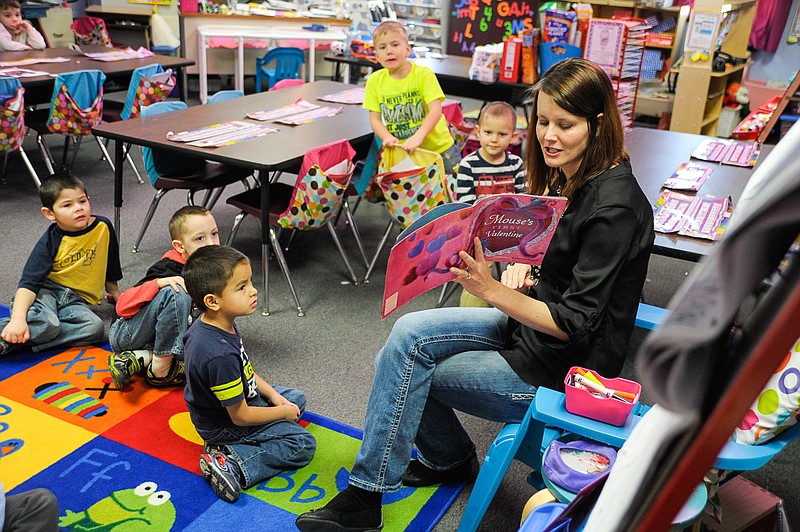While Jodeen Maness read a book aloud, 16 busy bodies did their best to sit still on the California pre-kindergarten classroom floor.
The four-year-olds had lots of questions and lots of ideas - not all of which related to the story. But the preschool teacher kept the conversation rolling and redirected back to the lesson. Then, she freed the little ones to release built-up energy through songs and motions.
After that, Maness enlisted the students into a "secret surprise" for Tawnya Clause for School Counselors Week. The students used scissors to cut out a construction paper heart and wrote their names inside, with extra drawings in some.
Then, they lined up and quietly walked down the hall - although there was wiggling and whispering, where Maness stapled the cards to the wall outside Clause's door.
In its second year, the pre-K program prepares children for kindergarten - group behavior, walking through hallways, getting along and a daily routine.
"They come in a lot more confident and ready to learn in kindergarten," Maness said.
As the Common Core Standards raise the expectations for incoming kindergarteners, the pre-K also helps students gain the knowledge they need to be prepared in the fall.
Today's kindergartners are expected to know what yesteryear's first graders knew, Maness explained.
"Pre-K is what kindergarten was a decade ago," she said. "In the last 50-100 years, children developmentally haven't changed."
She has been pleased with the progress this year's students have made since August. And this year's kindergarten teachers were pleased with performance of last year's pre-K students when they began in August 2014.
"They used to come in and learn everything in kindergarten," Maness said. Now, "this is an important transition into school."
But those who likely are the most pleased about the pre-K class outcomes are the parents like Amanda Tiberghien.
"Abby has learned so much more than I would have expected and what I could have done with her, she will be ready for Kindergarten mentally, emotionally and physically," Tiberghien said.
For students like Brooks Nichols, the pre-K classroom gave him a structured environment to improve his speech skills, his mother Staci Nichols said.
"He was so young and so behind, I didn't think he would get in," Nichols said. "We felt he needed a professional, beyond day care. That's why we were so excited to find out he was accepted.
Before Brooks entered Maness' classroom in August 2014, he couldn't form a full sentence. Within two week, his communication had improved dramatically.
"I was in awe," Nichols said. "He's grown leaps and bounds.
"We considered holding him back; now, he loves school and I think he'd miss it terribly."
Maness built the pre-K program three years ago, finding grants to cover the costs and writing her own curriculum.
With 13 years of experience, she is certified to teach up to sixth grade. But Maness said she enjoys the youngest students best.
"The little ones still love you," she said.

